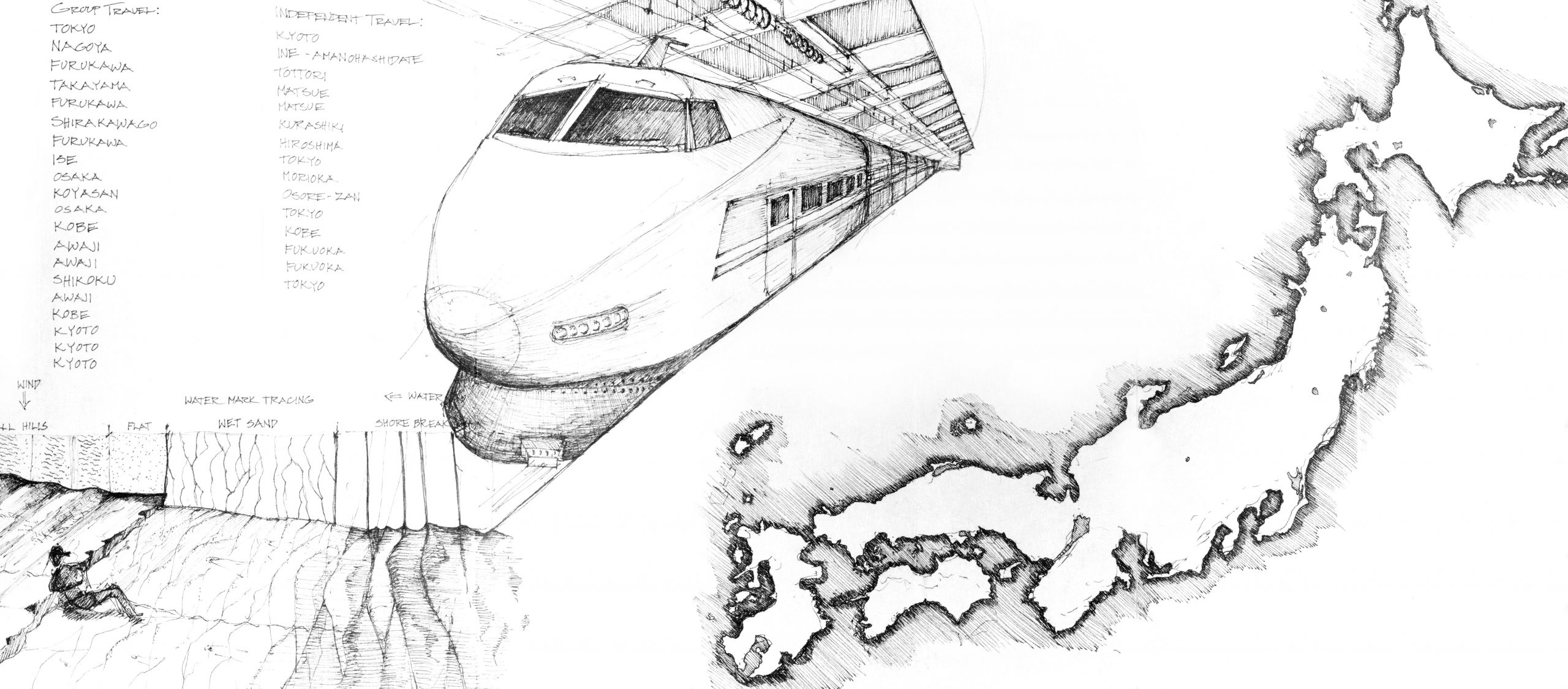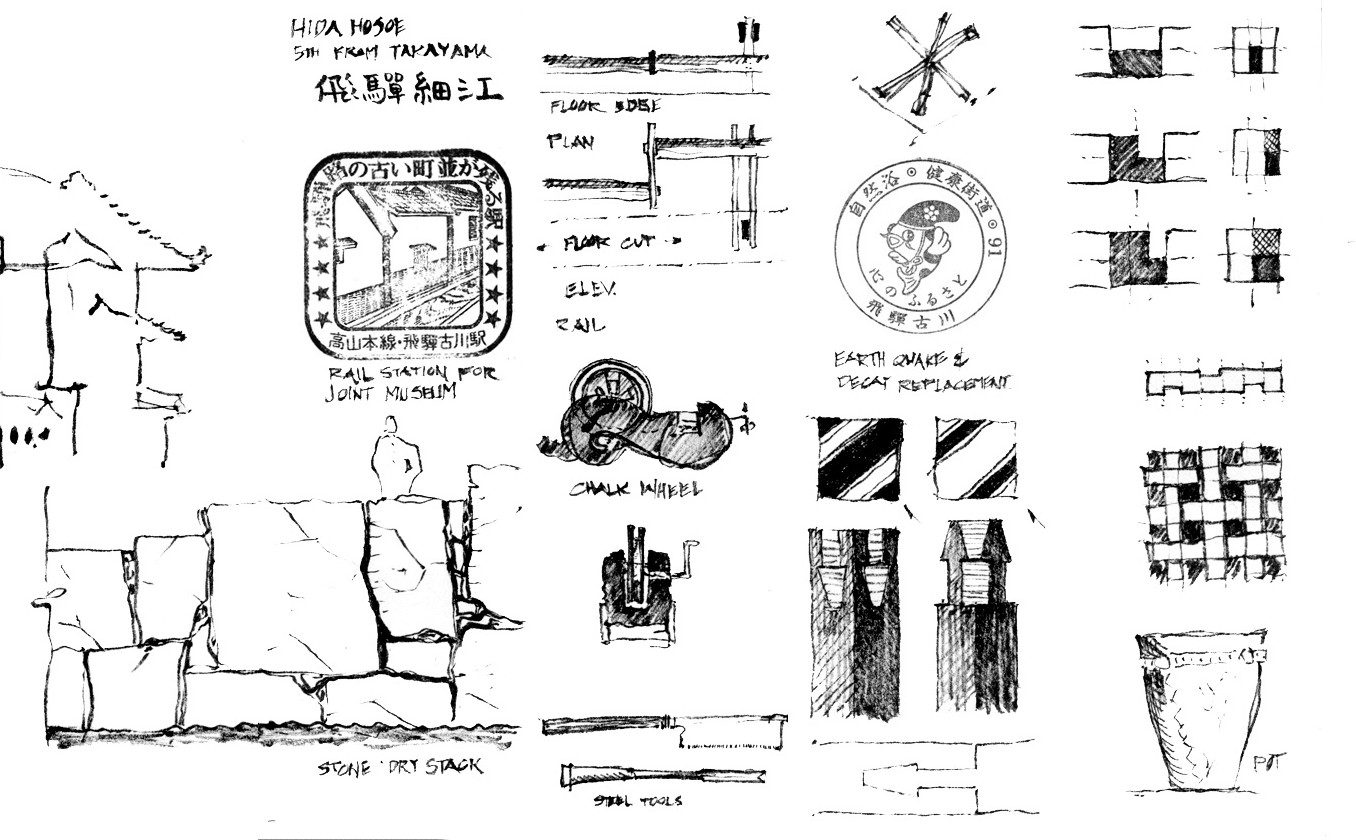5.19.Japan-4-detail-c Japanese roof tiles – Highlights Relevant to Sustainable Design:
Rethink the lifetime total cost of ownership of building envelopes starting with the roof.
Asphalt roof shingles are commonplace across the roofs of American homes. Many countries have used ceramic tiles for hundreds of years. In my travels to Italy, at the end of the 1980s, I saw firsthand the ubiquitous orange terra cotta tiles that covered the roofs of residential and commercial buildings in Florence. Years later in Japan, I saw the use of equally ubiquitous roof tiles. The orange Italian tiles are curved symmetrically like a shallow tunnel, while the gray Japanese tiles are curved more like a shallow wave. The upper left of the sketch below illustrates the wave curve. To learn more about the tiles, I visited a tile factory in Japan, and this sketch also shows, on the right side, an illustration of how hanging armatures carry the tiles in and out of the glazing booth.
The Japanese tiles often include significantly more ornamentation via round end caps than the Italian counterparts. The three different circular configurations are examples of regional ornamentation on the ends of roof tiles. The glazed ceramic tile may last hundreds of years, assuming they are spared from exceptionally violent earthquakes. When there are violent earthquakes, the light wood structures will rock from side to side, and in many cases, they collapse under the heavy weight of the roof tiles. All that remains is a pile of sticks covered with tile. Contemporary construction includes more reinforcement to prevent the earthquake damage. The S curve of the tiles is distinctive as is the cool blue-gray tint of the traditional glaze.
We have an abundance of clay in America, as evidenced by the extent of our brick buildings dating back to the eighteenth century, so I could not help but wonder why we did not adopt clay tiles. They typically last over fifty years, more than twice the average life of wood shakes or asphalt. I think that American settlers found it easier to cut wood and split logs into shingle “shakes” rather than build kilns for clay tiles. Slate was also prevalent as a resource and became a popular upscale solution. We should now perhaps reconsider clay tiles over asphalt, because they do not rely on petrol products. Clay tiles also reduce the waste in landfills and reduce the energy used in manufacturing and transportation, because they last so much longer than asphalt shingles. This approach speaks to the overriding theme of “Do it right from the beginning, and save money and energy down the road.”
Author and illustrator: Charlie Szoradi is an architect, inventor, and the CEO of Independence LED Lighting. He writes about many other topics related to Japanese roof tiles and roofing in other countries through his extensive travels around the world.
If you have found this posting online, it is an excerpt from Mr. Szoradi’s book Learn from Looking that served as the inspiring seed content for this drawing share resource. For additional drawings and insights on sustainable building materials such as Japanese roof tiles, we hope that you enjoy exploring LearnfromLooking.com. You can search via general terms such as sustainability as well as narrower terms such as Japanese roof tiles and tiles from other countries like Hungary.




I’m extremely pleased to discover this website. I wanted to thank you for ones time just for this fantastic read!! I absolutely enjoyed every part of it and i also have you bookmarked to see new stuff in your site.
Definitely, what a great blog and revealing posts, I definitely will bookmark your site. Best Regards!
I reckon something truly special in this website.
Some really great info, Gladiola I detected this. I’m not spaming. I’m just saying your website is AWSOME! Thank you so much! Please vist also my website.
Really nice design and good subject material. Please also check my website. I love cars!